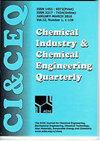经AOP联合放疗治疗拉米夫定和齐多夫定的疗效评价
IF 0.8
4区 工程技术
Q4 CHEMISTRY, APPLIED
Chemical Industry & Chemical Engineering Quarterly
Pub Date : 2021-01-01
DOI:10.2298/ciceq210309029l
引用次数: 1
摘要
自然界中药物污染物的存在是一个日益引起关注的环境问题。因此,有必要评估能够降解这些污染物的处理方法,例如高级氧化过程(AOP)。在这项工作中,应用光过氧化和光fenton AOP在水介质和合成废水(SE)中降解药物拉米夫定和齐多夫定的混合物。为此,一个台架反应器(UV-C;紫外线和阳光照射)。采用紫外/可见分光光度法评价AOP处理的效果。这些试验包括单独和联合辐照的应用。最佳操作条件为[H2O2]浓度为600 mg。L-1和[Fe] 0.5 mg。L-1时,两种基质的降解率分别为90.53%和89.32%,在水介质中光过氧化和光fenton工艺的降解率分别为88.69%和85.79%。动力学研究表明,两个伪一阶模型拟合良好,R2 > 0.93。对生菜、胡萝卜和番茄种子进行的毒性试验表明,在处理后将这三种种子放入溶液中,对这两种基质都有抑制作用,高效液相色谱分析证实了这一事实,其中证实了小峰的形成,表明形成了副产品。由此可以肯定,在UV-C辐射作用下,光fenton和光过氧化两种工艺都能有效降解药物混合物。本文章由计算机程序翻译,如有差异,请以英文原文为准。
Evaluation of combined radiation for the treatment of lamivudine and zidovudine via AOP
The presence of pharmaceutical contaminants in nature is an environmental problem generating increasing concerns. Due to this, it is necessary to evaluate treatments that are capable of degrading these contaminants, such as the advanced oxidation processes (AOP). In this work, the photoperoxidation and photo-Fenton AOP were applied to degrade a mixture of the drugs lamivudine and zidovudine, in aqueous medium and synthetic effluent (SE). To this end, a bench reactor (UV-C; UV-A and sunlight irradiations) was built. The AOP treatments efficiency was evaluated by ultraviolet/visible spectrophotometry. The tests involved the application of the irradiations individually and combined. The best operational conditions were [H2O2] of 600 mg.L-1 and [Fe] of 0.5 mg.L-1, for both matrices, with degradations of 90.53% and 89.32% for the photoperoxidation and photo-Fenton processes in aqueous media and 88.69% and 85.79% in SE. Kinetic studies showed a good fit for two pseudo-first order models with R2 > 0.93. Toxicity tests involving the application of lettuce, carrot, and tomato seeds showed an inhibition for the three seeds when submitted to solutions after treatment, for both matrices, this fact is corroborated by the HPLC analysis, in which the formation of small peaks was verified, suggestive of the formation of by-products. Thus, it can be affirmed that both photo-Fenton and photoperoxidation processes are efficient to degrade the drug mixture when applying UV-C radiation.
求助全文
通过发布文献求助,成功后即可免费获取论文全文。
去求助
来源期刊

Chemical Industry & Chemical Engineering Quarterly
CHEMISTRY, APPLIED-ENGINEERING, CHEMICAL
CiteScore
2.10
自引率
0.00%
发文量
24
审稿时长
3.3 months
期刊介绍:
The Journal invites contributions to the following two main areas:
• Applied Chemistry dealing with the application of basic chemical sciences to industry
• Chemical Engineering dealing with the chemical and biochemical conversion of raw materials into different products as well as the design and operation of plants and equipment.
The Journal welcomes contributions focused on:
Chemical and Biochemical Engineering [...]
Process Systems Engineering[...]
Environmental Chemical and Process Engineering[...]
Materials Synthesis and Processing[...]
Food and Bioproducts Processing[...]
Process Technology[...]
 求助内容:
求助内容: 应助结果提醒方式:
应助结果提醒方式:


